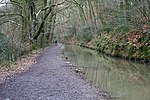Plym Valley Railway
Geographic coordinate listsHeritage railways in DevonLists of coordinatesStandard gauge railways in EnglandTourist attractions in Plymouth, Devon ... and 2 more
Transport in Plymouth, DevonUse British English from May 2017

The Plym Valley Railway is a 1 mile 14 chains (1.9 km) heritage railway based on part of the now-closed South Devon and Tavistock Railway, a branch line of the Great Western Railway in Devon, England. The line originally opened in 1859 and closed in 1962. Heritage first ran in 2001.
Excerpt from the Wikipedia article Plym Valley Railway (License: CC BY-SA 3.0, Authors, Images).Plym Valley Railway
Plym Valley Trail, Plymouth Leigham
Geographical coordinates (GPS) Address Nearby Places Show on map
Geographical coordinates (GPS)
| Latitude | Longitude |
|---|---|
| N 50.395 ° | E -4.083 ° |
Address
Plym Valley Trail
Plym Valley Trail
PL7 4NW Plymouth, Leigham
England, United Kingdom
Open on Google Maps





